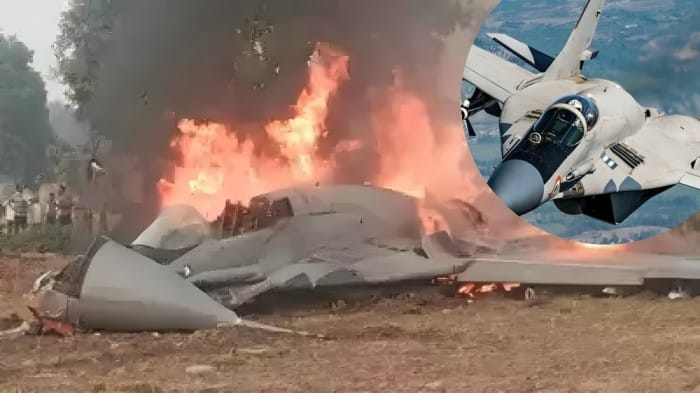An Indian Air Force MiG-29 fighter jet crashed today near Agra, raising concerns about aviation safety and the technical reliability of these aging jets. According to reports, the pilot had ejected safely, and no one lost their life. Video footage captured dramatic footage of the plane completely engulfed in flames on a bare open field in the Songa village. Witnesses reported that the locals at that distance were watching when responders in emergency services arrived at the scene. A few villagers even began picking pieces of the aircraft, and part of it appeared to be the ejection seat.

It issued a statement explaining how it crashed as a result of the “system malfunction” while it was performing routine training. I like that response by the IAF-they should have quick and transparent moves so the public trusts them more. The IAF reported that the pilot handled the situation with finesse and took the jet to a relatively safe crash landing area where the risk of damage to persons and property on the ground was at its lowest possible level before ejecting. It showcases the training these pilots have since they are made ready to tackle these complex situations at the slightest pressure. IAF has initiated an inquiry to know the exact reason for the malfunction.
#PlaneCrash के बाद पायलट और उसके साथी ने कूदकर अपनी जान बचाई। दोनों विमान से लगभग 2 किलोमीटर दूर सुरक्षित मिले जिन्हें मेरे बड़े भैय्या और चाचाजी ने सहारा देकर हॉस्पिटल पहुंचाया। देश की सेवा करने वाले जवानों की आज हमारे परिवार ने सेवा की।#IndianAirForce #Agra #Mig29 #fighterjet pic.twitter.com/BjY2astufF
— देश की बेटी इंदु (@Congress_Indira) November 4, 2024The MiG-29, or “Baaz” in the Indian Air Force, is a fighter jet designed originally in Russia. It was the first to be inducted into the IAF way back in 1987, a move that served to bolster India’s aerial muscle at a time when tensions in the region were high. The MiG-29 has been upgraded to meet modern standards over the years, and the latest version in India is the MiG-29 UPG, which has enhancements for better performance and improved safety features.
This is the second time in just two months that a MiG-29 has crashed, another MiG-29 went down during a night training sortie in Rajasthan back in September. Fortunately, in both incidents, the pilots ejected without any serious injury. At the same time, this pair of incidents does highlight concerns about the age of the Air Force fleet and whether the aircraft is more frequently maintained or upgraded.
A MiG-29 aircraft of the IAF crashed near Agra during a routine training sortie today, after encountering a system malfunction. The pilot manoeuvered the aircraft to ensure no damage to life or property on ground, before ejecting safely.
An enquiry has been ordered by the IAF,…
— Indian Air Force (@IAF_MCC) November 4, 2024The MiG-29 ejection seat is provided by Zvezda K-36D, which, for its part, ranks as one of the best worldwide. This “zero-zero” seat allows a pilot to safely eject from the jet even when it is at a standstill or flying at extremely low altitudes. This feature is invaluable, especially during emergencies at takeoff or landing, and has saved countless lives over the years. Interestingly, this type of technology was initially developed by Western countries, like the British with their Martin-Baker seats, before the Soviets developed their version. Now most of the fighter jets from around the world, including India’s own Tejas, use some version of zero-zero seats to protect their pilots.
🚨🚨 Very crazy visuals of Indian Air Force (IAF) MiG-29UPG jet in a flat-spin seconds before crashing nd after crashing…#PlaneCrash ! pic.twitter.com/0Jdcap6gVY
— Geography🌏🏞️ (@GeoStatics7372) November 4, 2024Though, in all ways, it is a lifeline, I do need to ask, can it not transcend this system and work toward preventing crashes instead of being post-crash escape devices? Though a very powerful vehicle, the MiG-29 is showing its age, and with each crash, pressure mounts on the IAF to phase out these jets, and perhaps replace them with more modern and reliable aircraft. This might be more practical because older jets become expensive to upgrade and repair, and at some point, it becomes just more cost-effective to purchase newer models that will have the safety and performance features straight from the factory.
In my view, it is another reminder to the Indians to review their air fleet and ensure they give them the safest tools they have for the pilots. The satisfactory machine for India has been the MiG-29, so far, perhaps the time is ripe to ask for higher upgrades and new acquisitions to ensure the safety of these pilots and maintain strong defense for Indians.
Minutes by M31GlobalNews






